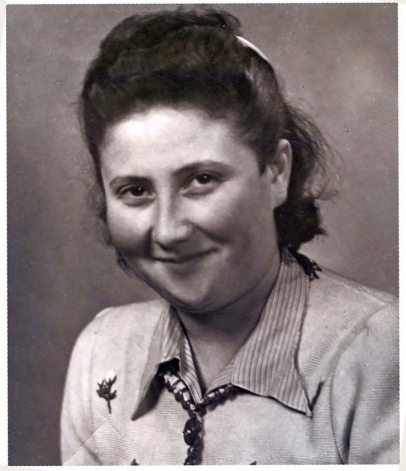Cabbage Rolls and Grant Wood
Old and New World recipes, with and without cookbooks
I would never have guessed that my mother and Grant Wood might share anything in common. Well, as it happens, my mother and Grant Wood do have one very unexpected thing in common: The best recipes for cabbage rolls – ever!
In 1950, my mother Ann and my father Fred came to the USA by ship from Germany, having miraculously lived through the Holocaust. Both were the sole members of large families to survive that terrible time. They brought to America exactly four suitcases, one government-issue wooden trunk, and their two-year-old son, my brother Jack. There were no cookbooks among their few possessions. Instead, my mother had memorized recipes for entrées, desserts, soups, breads, holiday specialties and other favorites from her family’s kitchen in her hometown of Szydlowiec, Poland.
Mother’s recipe for cabbage rolls was one of our family’s favorite winter foods. For all the 84 years of my mother’s life, she never wrote down the cabbage roll recipe which she had learned, word of mouth, from her mother. I learned how to make those cabbage rolls by standing alongside my mother just as she had with her mother before her. Only, I took notes on every detail, so I now have a written recipe of my mother’s mother’s cabbage rolls. It would take more than a World War for me to lose track of it.
Looking through my cookbooks recently, I rediscovered The American Gothic Cookbook, compiled by Joan Liffring-Zug [Penfield Press, 1979], which I had purchased at a garage sale somewhere in the Cedar Rapids/Marion area some time ago. The book had caught my attention at the garage sale merely because of the title, so I bought it on a whim, but I hadn’t actually opened it at the time.
As a child, I attended Grant Wood Elementary School in Cedar Rapids. Hanging on the walls of my school were reproductions of several of Wood’s paintings, which I came to love, and so through the years, I’ve sought to learn whatever I could about Grant Wood – both the artist and the person. After all, Grant Wood wasn’t just the name of my elementary school – he was, and will always be, a true native son of Iowa.
For years, The American Gothic Cookbook sat on the shelf in my home until just recently when I finally thought to open it. The book contains recipes from Grant Wood, his mother, his sister and others of German and Czech heritage living in Eastern Iowa. As I flipped through the pages, I came to Page 9. On that page was Wood’s recipe for cabbage rolls. I imagined Wood wearing his signature overalls standing at the stove in his kitchen at 5 Turner Alley in Cedar Rapids with a kettle of cabbage rolls on the cast iron stove.
Since I collect cookbooks, you might think that I like to cook; actually I don’t enjoy cooking as much as I love to assemble foods and plan meals. But collecting cookbooks gives me the pleasure to read recipes and conjure up what to assemble that will create a wonderful dining experience. Cookbooks find their way to my kitchen library from a variety of sources: garage sale shopping, as with The American Gothic Cookbook, new-and-used retail shops, church bazaars, and as gifts. One of those gift books was Amish Cooking [Pathway Publishing Corporation, 1977]. It was given to me several years ago by a fellow named Mike, whom I was dating when I lived in San Francisco.
Mike and I were visiting the San Gregorio General Store at the time. San Gregorio is one of my favorite places on the planet – a coastal town about forty-five minutes south of San Francisco. The San Gregorio General Store, with its well-worn hardwood floor, was a unique place that sold imported chocolate, fishing gear, overalls, hot coffee, beer, egg salad sandwiches, felt hats, greeting cards, massage oil, chewing tobacco, brooms, kerosene lanterns – and cookbooks.
While I was rummaging around through the cookbook section of the General Store, I spotted the Amish Cooking book and suddenly felt a wave of homesickness for Iowa. Although he could scarcely afford it, seeing me sniffling with that book in my hands, Mike bought the book for me on the spot.
Amish Cooking is a hardbound book with no extravagant color photos. The recipes are practical, purposeful and plain. The ingredients are all easy to find and the directions are simple to follow. Just visit any Amish community in Eastern Iowa and you’ll observe that Amish lifestyle and Amish cuisine are both delightfully free of affectation, and Amish Cooking reflects this aspect of Amish life beautifully. One of my favorite recipes from Amish Cooking is barbecue sauce. This sauce can be used with a great variety of dishes. I once used the sauce as a topping for my vegan lentil-squash loaf. I’d had a minor panic attack when I realized that the squash loaf recipe called for barbecue sauce, and my loaf was already in the oven when I read down to the part in the recipe that said “top with barbecue sauce.”
Oh, no! I’ve never even owned a bottle of barbecue sauce. I leafed through several cookbooks looking for a barbecue sauce recipe and every recipe called for ingredients that were not in my pantry. But while the loaf was still baking, I pulled Amish Cooking from my kitchen library. In the index, Barbecue Sauce was listed on Page 70.
How much more simple – more Amish – can you get than only five ingredients? The recipe called for sugar, which I adjusted by swapping honey for the sugar. The vegan lentil- squash loaf with home-made Amish barbecue sauce was a great success, and as the news spread, soon I was receiving requests from friends near and far for my loaf and Amish barbecue sauce recipes.
Recipes for cabbage rolls from Grant Wood’s recipe book and my mother Ann’s memory, as well as the Amish barbecue sauce follow. As it turns out, the kettle is the main difference between my mother’s cabbage rolls and Wood’s own recipe: Grant Wood cooked his cabbage rolls in a kettle on the stove top and my mother baked hers in a roaster in the oven. The choice between sugar and honey for the Amish barbecue sauce is up to you.
Cabbage Rolls – Grant Wood’s own recipe, a favorite
8 large cabbage leaves
1 lb. bulk sausage
2 cups cooked rice (or mashed potatoes)
1 tsp. salt
½ cup tomato juice
2 cups boiling water
3 tbs. vinegar
2 tbs. sugar
Mix well sausage, rice (or potatoes) and salt. Pour boiling water over cabbage leaves, let stand 4 minutes and then dry. Place meat mixture in equal portions on each leaf. Roll from stem end, folding in the sides. Tie each bundle with string or fasten with toothpicks. Place rolls in kettle and cover them with the liquid from tomato juice, boiling water, vinegar and sugar. Simmer until tender.
Cabbage Rolls – Ann Gilbert’s (born Chana Zylbersztajn)
Whole green cabbage
Yellow onion (small)
2 tbs. brown sugar
1 cup ketchup
2 cups water
Meat Filling, mix thoroughly:
2 lbs. ground beef, browned
3 eggs
3 slices rye bread (softened with boiled water)
Season to taste with pepper and a meat seasoning (my mother used Lawry’s)
Fill a big pot halfway with water and bring to a boil with whole, cored green cabbage. Put in pan upside down, with stem end facing toward the top of the pot. As leaves puff up, peel off with a long-handled wooden spoon. Use the smaller sized leafs to line the bottom of a large roasting pan. If desired, place a few rings of onion (about half an onion) over the cabbage lining. From the larger leaves, shave away thickness from the center stem of leaf. Take a couple of scoops of the meat filling and place on center of cabbage leaf. Roll from wider end of stem forward about halfway, fold sides in, then roll forward toward the end of the leaf. Place open edge downward on top of cabbage and onion lined roaster. Repeat process to use all meat filling. Mix the ketchup and water, and pour over top of all rolls. Place a few more onion rings (the other half of the onion) atop the rolls and sprinkle with the brown sugar. If you have some leftover cabbage leaves, use to cover everything in the roaster. Bake at 325 degrees for about 4 hours.
Barbeque Sauce – Amish style
½ cup ketchup
1 Tbs. vinegar
1 Tbs. sugar (may substitute with honey)
1 Tbs. mustard
1 Tbs. Worcestershire sauce (I omitted this)
Mix well. If too strong, use less ketchup, and some tomato juice.





